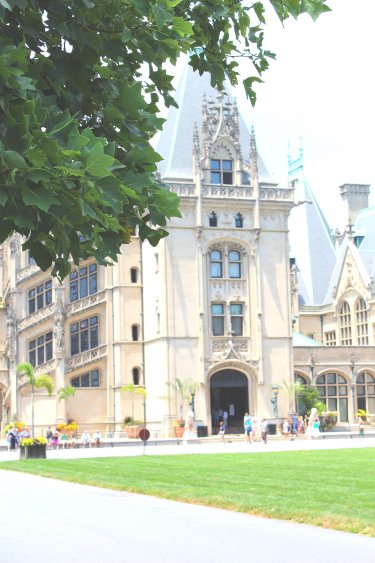Sites in the Blue Ridge Mountains
This summer my husband and I spent a lazy and relaxing week in the beautiful Appalachian Mountains. This visit took us through the Blue Ridge Mountains and the Great Smokey Mountains—and to two special resorts, the Westglow Resort and Spa in Blowing Rock, North Carolina and the Blackberry Farm north of Knoxville, Tennessee. En route—between these two destinations—we stopped in Asheville, North Carolina, to visit Biltmore, the extraordinary home of George Washington Vanderbilt which was built between 1890 and 1895. We spent the first part of the visit at the intimate and very special Westglow Resort and Spa in Blowing Rock, North Carolina.
Driving up from hot and muggy Charlotte, we arrived in the high, cool mountains mid-day. Blowing Rock is a charming, lively village that attracts visitors from all over the south and from the north as well.
After some research about Blowing Rock, we chose the Westglow Resort and Spa as the setting looked magnificent and we were ready to enjoy the outdoors and relax at the spa. We drove to the top of a steep and winding driveway, where the trees opened to present a magnificent view of the Blue Ridge Mountains.
Breathtaking view from the Westglow veranda
The Westglow Resort and Spa's main building is a stately Greek revival mansion built by the artist and author Elliott Daingerfield in 1917 at the end of World War I. Westglow was the summer retreat for Daingerfield who was an acclaimed landscape painter and writer. Soaring, majestic white Ionic columns, close to 25 feet tall, grace the front veranda. These were imported from Italy and sit at the edge of a wide wooden veranda with inviting, crisp white Adirondack chairs.
One can walk out to this wide porch through tall French doors in the living room and look straight ahead to the sun setting in the verdant Blue Ridge Mountains. We spent a few lazy afternoons on this veranda breathing in the fresh air and dramatic scenery.
Westglow Resort and Spa Veranda
We spent four days exploring Blowing Rock and Boone—birthplace of Daniel Boone— and Valle Crusis—learning about this historic part of western North Carolina. Boone is the home of the modern campus of Appalachian State University that boasts a top football team. Boone has a sweet, old-fashioned and unchanged downtown complete with a vintage drugstore and authentic soda fountain. Valle Crucis is a neighboring village with a tiny collection of buildings, the most famous of which is the original Mast General Store founded in 1883.

The Mast Country Store in Valle Crusis, North Carolina
The store has prospered through the last century and well into this one. The store has seven additional branches in other southern cities, however the piece de resistance is the original store in Valle Crucis. Sporting a weather beaten ESSO sign (the original name of Standard Oil before it became ExxonMobil), the white, wooden, sun bleached store is made up of a number of buildings cobbled together over more than one hundred years. Along with long forgotten candy brands and toys from yesteryear, they carry hunting equipment and clothing as well as hard to find cleaning products. I bought Fels Naptha and Octagon bars of soap and Twenty Mule Team Borax laundry soap.
The store has a very old fashioned and authentic post office that is still in use, Coca Cola coolers with original bottles inside and a host of white wooden rockers on the porch out back. The Mast General Store Annex (just down the road) has a selection of candy that would rival Dylan's Candy Bar in New York --Goobers, Sky Bars, Bazooka Bubble Gum, Necco Wafers, candy dots on paper and at least six different kinds of licorice. When we visited the newer branch of the store in Boone we found a more modern emporium, full of homey gifts as well as clothing, sporting goods and shoes for hiking, tennis and other sports. My husband bought hiking boots and socks and he is absolutely in love with these socks.
One of our goals was to visit Biltmore, the home in Asheville built by George Washington Vanderbilt, grandson of Commodore Vanderbilt of robber baron fame. We drove down from Blowing Rock to Asheville--a trip of close to two hours. We weren't sure what to expect, given the description of Biltmore as the largest home in the country. At the end of our five-hour visit, we were incredibly impressed with this architectural tour de force. In spite of its size (175,000 square feet) many of the rooms felt intimate and the layout of the house was extremely well planned.
The Biltmore Vanderbilt Estate in Asheville, North Carolina
Descendants of the Vanderbilt family still own the house and it has been subject to the best and most professional preservation techniques. Tapestries and other original pieces of art have been restored. Fabrics that have deteriorated have been replaced through the efforts of the curatorial staff in partnership with some of the factories that had supplied the original furnishings.
George Washington Vanderbilt was 33 years old and single when he built this fantastically imaginative home. Richard Morris Hunt was the architect and Frederick Law Olmsted the landscape architect. The house is fashioned after a number of important French chateaux. Biltmore is enormous, however, the rooms, in many cases, have a feeling of comfort and intimacy not often felt in a large English Stately Home.
Vanderbilt married a few years after building the house and he and his wife entertained in the elaborate fashion that was typical of the late Victorian era both in the large country houses in Great Britain and the Unites States.
We signed up for a special visit called the Butler's Tour which gave us real insight about how this extraordinary home was run. You can read more about it in my next blog entry.




